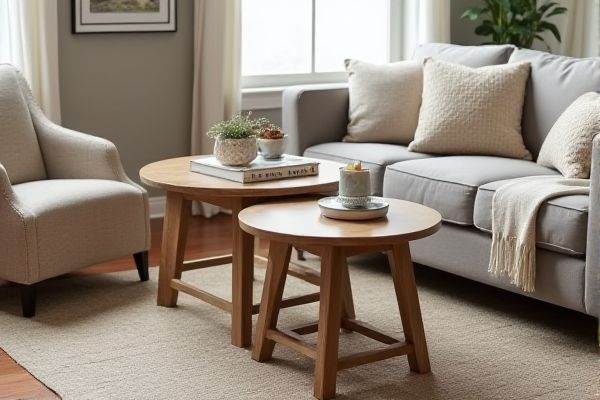
Nesting tables save space by fitting smaller tables under a larger one, making them ideal for compact areas and flexible use. Discover how choosing between nesting and end tables can transform Your living space by reading the rest of the article.
Table of Comparison
| Feature | Nesting Tables | End Tables |
|---|---|---|
| Definition | Tables placed within another table cell to organize complex data hierarchies. | Standalone tables designed to summarize or conclude data sections. |
| Use Case | Used for detailed breakdowns or multi-level data representation. | Used as summary or final data presentation points at the end of sections. |
| Complexity | Higher, due to multiple layers and structure management. | Lower, simpler structure focusing on concise data display. |
| Readability | Can reduce readability if overused or poorly formatted. | Improves readability by clearly separating summary information. |
| Performance | May slow down rendering in browsers due to nesting depth. | Optimized for faster rendering and easier parsing. |
| Semantic Optimization | Requires careful HTML semantics to maintain accessibility and SEO. | Easier to optimize semantically, improving SEO and screen reader use. |
| Accessibility | Potentially problematic if nesting disrupts table structure recognition. | More accessible, straightforward table layout. |
Introduction to Nesting Tables and End Tables
Nesting tables offer a space-saving design with multiple tables that can be stacked or separated for flexible use, making them ideal for small living areas or dynamic layouts. End tables are standalone pieces typically placed beside sofas or chairs to hold lamps, drinks, or decor, providing convenient surface space within arm's reach. Understanding the distinct functions of nesting and end tables helps you choose the best option to complement your room's style and functionality.
Key Differences Between Nesting Tables and End Tables
Nesting tables are designed to stack or slide under each other, offering versatile space-saving solutions ideal for small living areas, while end tables typically stand alone beside sofas or chairs. Nesting tables provide multiple surfaces that can be separated or combined as needed, whereas end tables usually offer a single, fixed surface for lamps, decor, or essentials. The key differences lie in their functionality, space utilization, and flexibility in arrangement within living room setups.
Design and Aesthetic Appeal
Nesting tables offer a versatile design with multiple-sized surfaces that fit seamlessly together, enhancing spatial efficiency and modern appeal in living areas. End tables present a classic, standalone aesthetic, often featuring sculptural designs or storage compartments that complement sofas and chairs. Both types elevate interior decor, with nesting tables promoting a layered, dynamic look, while end tables provide focal points through distinctive shapes and finishes.
Space-Saving Benefits
Nesting tables offer superior space-saving benefits by allowing multiple smaller tables to be stacked neatly under a larger table, maximizing floor space in compact living areas. End tables occupy a fixed footprint next to seating and lack the flexibility to be combined or stored compactly when not in use. The versatility of nesting tables makes them ideal for small apartments or rooms where efficient use of space is critical.
Functionality and Versatile Uses
Nesting tables offer exceptional functionality by providing multiple small surfaces that can be stacked to save space or separated for flexible seating arrangements, making them ideal for compact living areas. End tables serve as sturdy standalone pieces, perfect for placing lamps, drinks, or decorative items alongside sofas or beds, enhancing both convenience and style. Your choice depends on whether you prioritize space-saving versatility with nesting tables or the straightforward, singular use of end tables.
Material and Construction Comparison
Nesting tables typically feature lightweight materials like engineered wood, metal frames, or MDF combined with particle board, designed for easy stacking and mobility. End tables often utilize solid hardwoods such as oak, walnut, or maple, with sturdy constructions aimed at long-term durability and aesthetic appeal. While nesting tables prioritize versatility and compactness through minimalistic construction, end tables focus on robust craftsmanship and heavier materials for stability and decorative presence.
Best Placement for Each Table Type
Nesting tables are best placed where flexible surface space is needed, such as next to a sofa or in a small living room, because they can be stacked or spread out as required. End tables work well beside chairs or couches, providing a stable spot for lamps, drinks, or personal items within arm's reach. When choosing your arrangement, consider how often you need to free up space or have multiple surfaces accessible simultaneously.
Popular Styles and Trends
Nesting tables are favored for modern, minimalist interiors due to their space-saving stacking design and versatility in small living spaces. End tables often showcase classic, rustic, or mid-century modern styles, serving as statement pieces beside sofas or beds with decorative finishes like wood grain or metal accents. Popular trends highlight nesting tables with sleek metal frames and tempered glass tops, while end tables trend towards multifunctional designs with storage drawers or built-in lighting.
Pros and Cons of Nesting Tables vs End Tables
Nesting tables offer space-saving advantages by fitting multiple tables into one compact unit, making them ideal for smaller living areas, whereas end tables provide more stable, singular surface areas typically used for lamps or decorations. Nesting tables can be easily rearranged for versatile use but may lack the sturdiness and permanence of traditional end tables. Your choice depends on whether you prioritize flexibility and space efficiency or stability and style in your living room setup.
How to Choose Between Nesting and End Tables
Choosing between nesting tables and end tables depends on available space and functional needs; nesting tables offer compact storage with flexible configurations, making them ideal for small or multi-purpose rooms. End tables provide a more permanent surface next to seating areas, often featuring additional storage that complements traditional living room setups. Prioritize nesting tables for versatility and space-saving, while end tables suit fixed placement and enhanced accessibility for everyday use.
 homyna.com
homyna.com